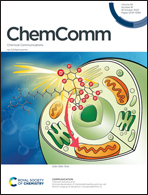Progress in organic photovoltaics based on green solvents: from solubility enhancement to morphology optimization†
Abstract
Solution-processed organic photovoltaics (OPVs) is one of the most promising photovoltaic technologies in the energy field, due to their clean and renewable low-cost manufacturing potential. OPV has rapidly developed with the design and synthesis of highly efficient photovoltaic materials and the development of smart device engineering. To date, the majority of advanced OPV devices have been prepared using halogenated solvents, achieving power conversion efficiencies (PCE) exceeding 19% on a laboratory scale. However, for industrial-scale production, less toxic manufacturing processes and environmental sustainability are the key considerations. Therefore, this review summarizes recent advances in green solvent-based approaches for the preparation of OPVs, highlighting material design (including polymer donors and small molecule acceptors) and device engineering (co-solvent methods, additive strategies, post-treatment methods, and regulation of coating method), emphasizing crucial factors for achieving high performance in green solvent-processed OPV devices. This review presents potential future directions for green solvent-based OPVs, which may pave the way for future industrial development.



 Please wait while we load your content...
Please wait while we load your content...